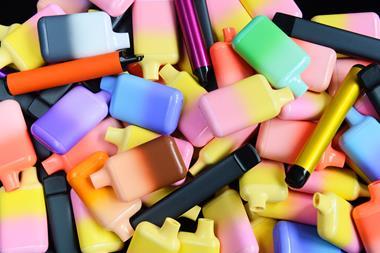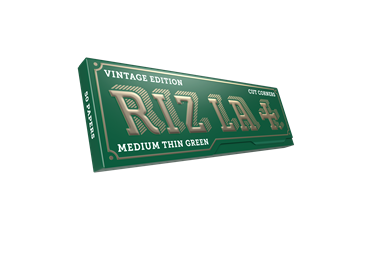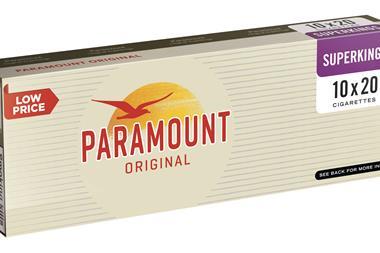The number of UK vapers has almost doubled over the past two years as traditional tobacco smokers give the e-cigs category a try
Like Brexit and Trump, electronic cigarettes (e-cigs) and other vaping devices take their place among some of the most hotly debated subjects of 2016.
In fact, the growing category - which is now thought to be worth £450m in the UK, according to Blu, and used by an estimated 2.8 million people (predominantly former and current smokers) - has rarely been out of the news this year, as health experts, legislators and retailers dispute vaping’s pros, cons and future developments.
The category hit the headlines a number of times in September alone, with the British Heart Foundation questioning the impact of nicotine-containing e-cigs on vapers’ heart health, followed just a few days later by a new report published in the British Medical Journal which claimed that increased e-cig usage was helping conventional smokers to quit more successfully.
Vaping products themselves are becoming increasingly visible as convenience stores, newsagents and other grocery retailers move away from cluttered and confusing counter-top units towards high-impact back wall and standalone shop floor displays.
And with tobacco products now hidden from view and new European Tobacco Product Directive (EUTPD) laws already fuelling a dramatic reduction in the number of tobacco SKUs, the prominence of e-cigs in convenience stores looks set to increase in the months ahead.
Companies such as Real Trading, which provides convenience stores with bespoke, lit displays containing room for several leading brands and associated hardware, are enjoying booming business, while JTI is currently rolling out a new gantry solution that puts e-cigs, and its Logic Pro tank system, firmly in the spotlight.
Arjan Mehr of Londis Great Hollands in Bracknell, Berkshire, is just one retailer already tasting success with the new JTI unit, which allows tobacco products to be kept hidden behind doors on one side, while the other is left open to display e-cigs.
“This solution is a great way to merchandise e-cigs,” he says. “I think it’s important to site e-cigs and tobacco together on the back wall. JTI’s approach creates space which will allow me to showcase a wide range, which is critical in driving footfall.”
Dee Sedani of One Stop Matlock, Derbyshire, is another: “The new-look unit is working really well. I’m able to draw attention to the growing e-cig opportunity with a dedicated space, while also managing the category responsibly,” he says.
In Cobham, Surrey, another retailer who extols the virtues of a high-impact standalone vaping display is David Worlsfold of Farrants.
“Visibility is without a doubt one of the most important factors in driving sales of vaping products,” he says.
“We have a striking standalone unit, designed and built by premium vaping brand Liberty Flights, positioned on the shop floor, but immediately next to the counter and main tills. The large black unit allows products to really stand out and we stock a wide range of kits, cartomizers and liquids in all manner of flavours and nicotine strengths to give new and existing vapers a vast range of options.
“The fact that the unit is on the shop floor allows existing vapers and new converts to browse the full range unrestricted, yet counter staff are immediately on hand should they require advice.
“Our approach is clearly working as we sell upwards of £2,000-worth of vaping products a month, and that figure is growing.
“I’m a strong believer that if you decide to take on a new category you should own it and that’s what we are doing with vaping products.”
The vaping category also lends itself perfectly to impactful promotions.
Jennifer Roberts, UK category controller at Blu, says that multi-buy activities on liquids - such as ‘two for £8’, for example - are a great way to boost interest and sales. “Clearomisers are also a great way to drive additional sales and margin as consumers should change these units every few weeks,” she says.
“Ensure you stock the clearomisers for the tank brands you stock and remind your customers to buy them every time you sell a bottle of liquid,” she concludes.
Scott Rothwell, owner of Eaves Lane Londis, Chorley, Lancashire, is certainly reaping the rewards a well-managed and promoted e-cig range can bring, selling almost £1,000-worth of vaping products a week.
His vast range of e-liquids is a big draw for local vapers, and the bottles, which he buys in for between £3.24 and £4.25, sell for £10 each, or as part of a popular ‘three for £25’ deal.
However, keen to maintain momentum, Scott has been focusing heavily on promotion and ways of driving repeat purchase, developing a loyalty card scheme in the process.
Cardholders who buy into the store’s ‘three for £25’ e-liquid deal nine times get their 10th purchase for half-price at £12.50.
And as with any rapidly-developing category, but particularly one which is subject to so much new legislation and debate, education is key.
“Vaping is a journey and we strive to support our customers on it at every step,” David adds. “Tobacco smokers looking to switch to vaping are always a bit recalcitrant at first, it’s as though they almost want the experience to fail. That’s why it’s so important to really understand the category so you can recommend the correct products for their needs.
“It’s important that new vapers understand that it’s not a silver bullet to give up smoking, more of a bronze one, and there might be a little trial and error at first.
“That’s why choice is key. Vaping is an investment and new vapers don’t want to see just one car in the showroom, they want to see a range of options. Inevitably, though, once we’ve taken them through all their options, first-timers tend to buy the same sort of product: our entry-level kit which includes a tank, rechargeable battery and a liquid for £19. Taking the time to talk them through their options and getting them on the right sort of product that includes the right level of nicotine content is well worth it, as when it works, new vapers become almost evangelical about it and you benefit from strong loyalty,” he adds.
So how is the market developing? According to a new report produced by Ernst & Young (E&Y) for BAT-owned Nicoventures, 4% of the UK population now vapes and the number of UK vapers has almost doubled over the past two years, fuelled by “the perception of relative health benefits compared with combustible cigarettes”.
As most vapers are either current or ex-smokers, the lower price of e-cigs when compared with combustible tobacco products was found to be a factor, but not a driving one.
The UK market can be broadly divided into three key categories, according to the report. These are: disposable products - which can be discarded when the pre-filled cartridge of e-liquid is empty; rechargeable products - which are designed to be refilled by the user.; and modular products - which can also be refilled by the user, but also allow users to regulate the power delivered from the batteries to the atomizer.
Modular devices have overtaken rechargeable as the most commonly-used type of device by UK vapers. Modulars are now chosen by 59% of UK vapers compared with 39% of users who use rechargeable e-cigs. The least popular devices are disposables, which now account for just 16% of sales.
As the vaping category becomes better established, regulated and trusted, these pricier, more complex modular devices are growing increasingly popular with first-time vapers. In fact, according to E&Y, 27% of new UK vapers now start off using a modular device. Just over 30% use a disposable product, while most (41%) take their first puffs on a rechargeable product.
Liquid lines
Understandably, the booming sales of modular products are driving an associated increase in sales of e-liquids. Jennifer Roberts, UK category controller at Blu, elaborates: “We’re seeing more and more consumers entering the category going straight into the ‘open’ liquid systems (tank kits and e-liquids), with more than 40% of value share in the market coming from e-liquids and e-liquid systems.”
She adds: “E-liquid formats remain the fastest-growing area of e-cigs in the UK, growing at 102% year on year due to the value savings, greater flavour range and the increased product performance they offer (Nielsen scantrack 52 weeks to 13 August 2016).
“To offer consumers a real choice we recommend retailers stock a range of flavours and strengths to suit different needs.”
According to the latest JTI insight, the three most popular vaping flavours are menthol (37%), followed by fruit (30%), then tobacco (29%).
Nicotine
Just as with flavours, UK vapers can choose from a wide range of nicotine strengths, including 0% nicotine, which is growing in popularity.
In the UK, 65% of vapers’ most commonly-used devices contain between 1 and 11mg of nicotine, according to E&Y. Just under 20% of devices currently smoked contain 12 to 18mg of nicotine, while 13% are nicotine-free. Only 5% of consumption is accounted for by nicotine strengths of 18mg plus - good news considering the EUTPD will ban the production of e-liquids containing more than 20mg/ml in November.
It’s vital that retailers have a wide range, and firm understanding, of the different nicotine strengths that they offer, says e-cig brand Vaporized. Allowing a new vaper to buy the wrong one can lead to a negative experience and potentially hamper future sales.
With most vapers using e-cigs as a way to cut down or stop smoking tobacco, Vaporized suggests that retailers always ask new and existing vapers about their tobacco smoking habits. Questions such as how many cigarettes do they, or did they, smoke a day and which brand can help retailers work out the correct nicotine strength for them.
As a rough guide:
6mg/0.6% (low) - up to 10 cigarettes a day
12mg/1.2% (medium) - up to 20 cigarettes a day
18mg/1.8% (high) - up to 30 cigarettes a day
David Worlsfold recommends that existing smokers switching to vaping use a 1.8% nicotine strength e-liquid at first “so that they get a similar sort of nicotine hit to tobacco”.
“We then find that within a few months the level naturally reduces to 1.2% and we are now seeing growth of nicotine-free e-liquids,” he says.
Legal lowdown
EUTPD laws also apply to cigarettes and rolling tobacco. Liquid refill bottles cannot contain more than 10ml of liquid and products cannot contain more than 20mg/ml of nicotine. Packaging will need to contain health warnings and correct labelling, be tamper resistant and child proof, and products must also be registered with the Medicines & Healthcare products Regulatory Agency.
According to Blu, suppliers and manufacturers are “busy putting their plans in place for being compliant.”
“There are significant costs involved in this, so many brands are expected to drop out of the market,” Blu’s Roberts adds.
Danny Sohota, of specialist vaping distributor Real Trading, agrees. “There are more than 900 brands on the market, with this estimated to reduce by at least 50% when EUTPD kicks in,” he says.
Top 10 e-cig brands in convenience
1. Vivid
2. Blu
3. E-lites
4. Nicolites
5. Multivape
6. Vapouriz
7. Kik
8. Vype
9. Liberty
10. One Lite
Source: IRI
UPDATE on legislation
20 May 2016
Phase 1: Advertising and promotion restrictions came into effect, restricting TV, radio, consumer press and social media advertising
Retailer action: Increase visibility and POS in-store to drive awareness and sales
20 November 2016
Phase 2: Production of non-compliant stock must cease
Retailer action: Understand what compliant products look like and start to promote existing stock to sell-through
20 May 2017
Phase 3: The sale of non-compliant stock is no longer allowed
Retailer action: It is now retailers’ responsibility to stock and sell fully-compliant products. Blu recommends buying only compliant stock post-January 2017 to give retailers time to sell through old stock.
Source: Blu
E-liquids: Mind your Ps and Vs
E-liquids can contain a mix of two, or sometimes three, key ‘diluents’ alongside flavour and maybe nicotine. These diluents are known as PG, VG, and sometimes AG, and each boasts a particular set of attributes to suit different vaping needs.
PG stands for propylene glycol. It’s a thin, clear, odourless liquid which has long been used as a preservative and flavour carrier in food products, and is well-liked for its ability to carry, and even enhance, e-liquid flavours and deliver a “strong throat hit”.
VG stands for vegetable glycerine. The thick and naturally sweet liquid is made from vegetable oil and is also commonly used in food products, cosmetics and toothpaste as a sweetener.
VG-based e-liquids deliver a smooth vaping experience, without the same strong throat hit as PG. They are also renowned for their ability to create large vape clouds, but due to the liquid’s thickness VGs can require more power to vape.
AG stands for aqueous glycerine. This is a VG diluent with the addition of de-ionised water to thin the mixture.
Many e-liquids contain a combination of PG and VG to help vapers achieve a good ratio of vapour, flavour, and ‘throat hit’, so it’s well worth noting the mix included in the products for sale in your store.
Top drivers of e-cig use
61% To reduce smoking.
59% Vaping is perceived to be less harmful than cigarettes.
50% Enjoyment of the taste and vaping experience.
Source: Ernst & Young




























No comments yet